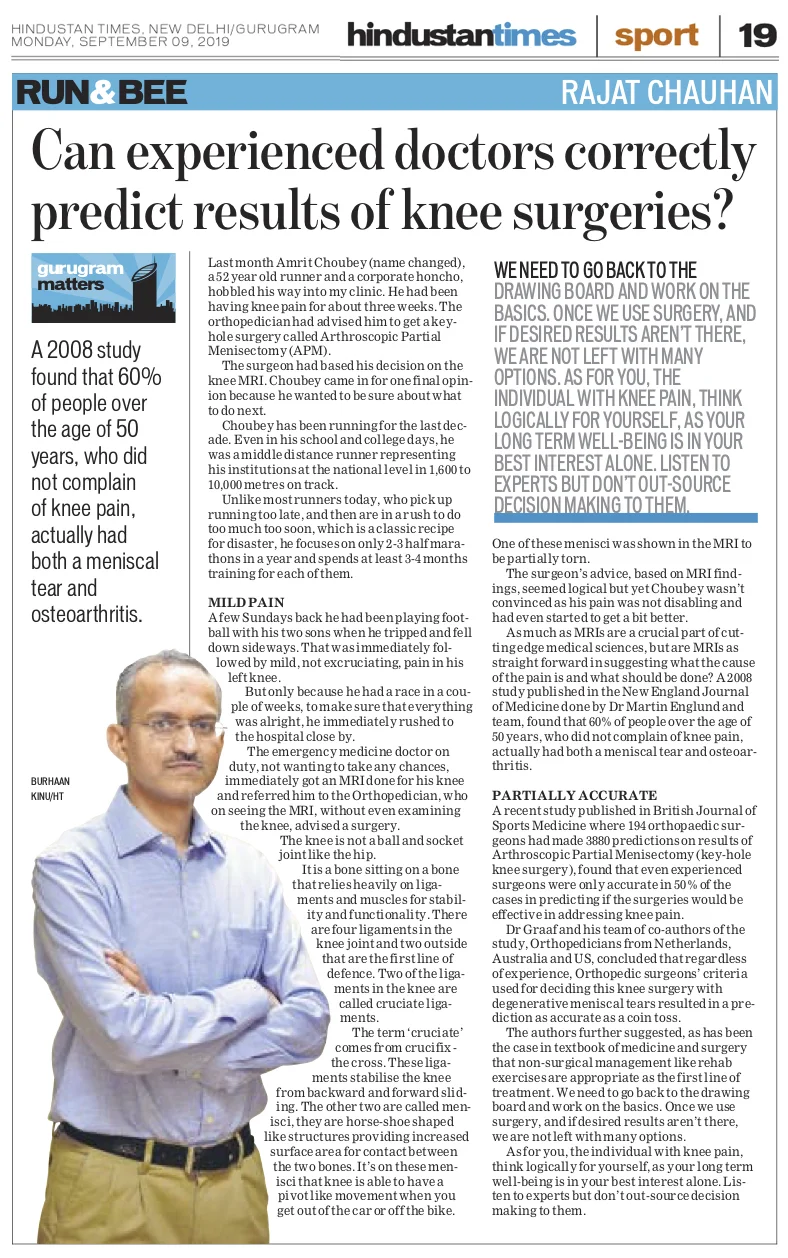Can experienced surgeons correctly predict the outcome of knee surgeries?
Extended version of my column Run&Bee in Hindustan Times
Week 63: Can experienced doctors correctly predict the outcome of knee surgeries?
Pic via UnSplash by Jon Tyson @jontyson
Last month Amrit Choubey (name changed), a 52 year old runner and a corporate honcho, hobbled his way into my clinic. He had been having knee pain for about three weeks. The orthopedician had advised him to get a key-hole surgery called Arthroscopic Partial Menisectomy (APM). The surgeon had based his decision on the knee MRI. Choubey came in for one final opinion because he wanted to be sure about what to do next.
Choubey has been running for the last decade. Even in his school and college days, he was a middle distance runner representing his insitutiitions at the national level in 1,600 to 10,000 metres on track. Unlike most runners today, who pick up running too late, and then are in a rush to do too much too soon, which is a classic recipe for disaster, he focuses on only 2-3 half marathons in a year and spends at least 3-4 months training for each of them.
Pic via UnSplash by Jannik Skorna @jaenix
A few Sundays back he had been playing football with his two sons when he tripped and fell down side ways. That was immediately followed by mild, not excruciating, pain in his left knee. But only because he had a race in a couple of weeks, to make sure that everything was alright, he immediately rushed to the hospital close by.
The emergency medicine doctor on duty, not wanting to take any chances, immediately got an MRI done for his knee and referred him to the Orthopedician, who on seeing the MRI, without even examining the knee, advised a surgery.
Pic via UnSplash by 5theway vietnam @5thewayvietnam
The knee is not a ball and socket joint like the hip. It is a bone sitting on a bone that relies heavily on ligaments and muscles for stability and functionality. There are four ligaments in the knee joint and two outside that are the first line of defence. Two of the ligaments in the knee are called cruciate ligaments. The term ‘cruciate’ comes from crucifix - the cross. These ligaments stabilise the knee from backward and forward sliding. The other two are called menisci, they are horse-shoe shaped like structures providing increased surface area for contact between the two bones. It’s on these menisci that knee is able to have a pivot like movement when you get out of the car or off the bike. One of these menisci was shown in the MRI to be partially torn.
The surgeon’s advice, based on MRI findings, seemed logical but yet Choubey wasn’t convinced as his pain was not disabling and had even started to get a bit better.
“60% of people over the age of 50 years, who did not complain of knee pain, actually had both a meniscal tear and osteoarthritis. ”
As much as MRIs are a crucial part of cutting edge medical sciences, but are MRIs as straight forward in suggesting what the cause of the pain is and what should be done?
A recent study published in British Journal of Sports Medicine where 194 orthopaedic surgeons had made 3880 predictions on results of Arthroscopic Partial Menisectomy (key-hole knee surgery), found that even experienced surgeons were only accurate in 50% of the cases in predicting if the surgeries would be effective in addressing knee pain. Dr Graaf and his team of co-authors of the study, Orthopedicians from Netherlands, Australia and US, concluded that regardless of experience, Orthopedic surgeons’ criteria used for deciding this knee surgery with degenerative meniscal tears resulted in a prediction as accurate as a coin toss.
The authors further suggested, as has been the case in textbook of medicine and surgery that non-surgical management like rehab exercises are appropriate as the first line of treatment.
“Don’t get me wrong. Surgeries like this play a very important role improving the quality of life, but the question is, are they being done too soon and too often?”
Pic via UnSplash by bruce mars @brucemars
“We need to go back to the drawing board and work on the basics. Once we use surgery, and if desired results aren’t there, we are not left with many options.
As for you, the individual with knee pain, think logically for yourself, as your long term well-being is in your best interest alone. Listen to experts but don’t out-source decision making to them. ”
Print version of the column as it came in Hindustan Times on 9.9.i9





